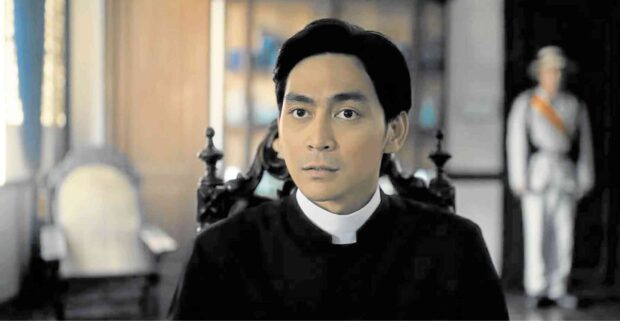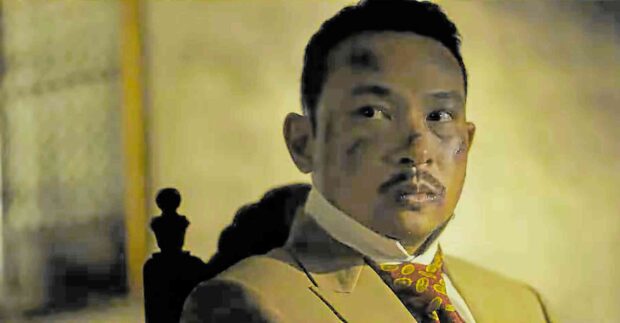Why shooting garrote scene felt ‘surreal,’ ‘divine’ to ‘GomBurZa’ director, cast

Cedrick Juan as Jose Burgos —PHOTOS BY JESCOM TV
The death scene of the three martyr priests via garrote in “GomBurZa” was what the film’s lead actors found the most memorable. It is also what’s expected to make the biggest impact on the audience when the historical drama starts screening nationwide on Christmas Day, its director Pepe Diokno declared.
The garrote scene was shot in one day, he recalled, “from morning until the magic hour.” The lines of Filipino priests Mariano Gomez, Jose Burgos and Jacinto Zamora (or GomBurZa), were “delivered word for word, coming from historical accounts,” he added.
The garrote is a device—an iron collar attached to a post—that was used to execute condemned people. The three Filipino Catholic priests were executed using this on Feb. 17, 1872 in Bagumbayan, on charges of subversion arising from the 1872 Cavite mutiny.
“Specifically for Burgos, it was said that, in some readings, he died crying, that he appeared cowardly as he repeatedly screamed of his innocence. But we read this as defiance. He needed to say that they did nothing wrong, and this inspired the people to say the same thing about them. If Burgos didn’t say those lines, the people might not have joined him. It was his defiance that sparked the emotions of the people,” Diokno told Inquirer Entertainment in a recent interview.

Dante Rivero as Mariano Gomez
Iconic
Ketchup Eusebio, who played the whistleblower Francisco Zaldua in the film, said that growing up, he has always associated the word ‘garrote’ to the death of GomBurZa. “The day we shot the garrote scene was really memorable. We were already carrying the heavy emotion connected to the death scene even while we were still setting up the place,” he recalled. “Nakisama rin ang panahon. It had been so hot at noon, but later in the day, we noticed the wind starting to pick up. If you look closely, you’ll see that the hats of the Spanish characters were all clipped to their heads to keep them from getting blown away. Everything else was flying away because the wind had suddenly decided to blow the hardest.
Article continues after this advertisement“The clouds became darker and darker, eventually. It was as if the clouds knew there was something divine that was about to happen. That’s the scene that made a huge impact on me personally. I expect it to eventually become iconic,” said Eusebio.
Article continues after this advertisementThe garrote scene was what also moved Cedrick Juan (who plays Burgos) to tears when he finally saw the movie for the first time. “While on the set, I watched all the characters being executed and took all these in. When it was Burgos’ turn, I looked at the crowd, as well as the mountains surrounding us. Enchong was right, while it was not 100-percent accurate, it really felt like I was transported to Bagumbayan at the time of the execution. If that scene would not make an impact on the audience, then I don’t know what will. It made me understand the purpose of GomBurZa’s death—it inspired Filipinos to take action.”
Carlitos Siguion-Reyna, who plays a Spanish priest in the film, said that even though he was not part of the garrote scene, he appreciated it the most. “Growing up, I would pass by the garrote sculptures (GomBurZa monument) on my way to school. I took that for granted. Seeing the scene now brought back a lot of childhood memories,” he told Inquirer Entertainment.

Enchong Dee as Jacinto Zamora
Memorable
Siguion-Reyna worked for only a day on the set in Tayabas, Quezon, “but what I really appreciated were the talks I’ve had with the film’s technical consultants, Fr. Ro Atilano and Fr. Rene Avellana,” he said. “They generously shared their knowledge on the background context of the events and the film’s characters.”
Diokno said the film was also shot in Taal, Batangas, his hometown. “The place is beautiful. I would wake up in the morning and welcome the chance to walk to our set. At the end of the day, we would walk back to rest, as well. We purposely did this to imbibe the beauty and calmness of the location,” he recalled.
“Shooting in Tayabas was equally memorable, what with its beautiful old buildings and the church there. People were so generous to allow us to use them. Also in Intramuros, it was surreal to have shot our prison and battle scenes there. It was fun to be in all these set locations.”

Ketchup Eusebio as Francisco Zaldua
‘Contribution to my country’
Eusebio agreed with Diokno about enjoying work on the set. “Even though we felt the heavy emotion while shooting the movie’s ending, I remember how we had so much fun. The lock-in set in Taal was really ideal. It was like being transported to the past just by looking at the mountains, the cobblestone streets, and even the costumes worn by the people around you,” Eusebio said. “Also, most of the cast members were boys. It was fun hanging out with them inside our tents. We were happy and excited because we knew we were doing something good.”
Enchong, who plays Zamora, said the entire film was memorable. “I will remember this film as my contribution to my country. One has to have a reason for doing a project that he agrees to become part of, be it a barkada film or a love story. Now at least, I can proudly say that I have a film for my country,” he explained.
“GomBurZa,” coproduced by Jesuit Communications and MQuest Ventures, is an official entry to the 2023 Metro Manila Film Festival, which will run from Dec. 25, 2023 to Jan. 7, 2024.